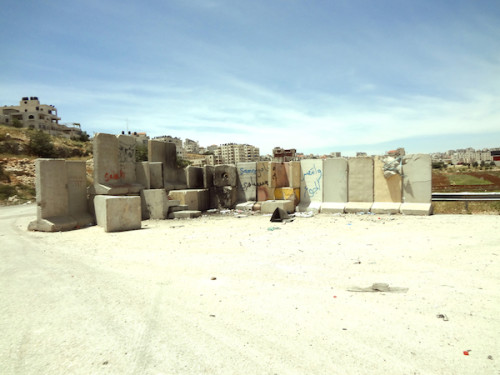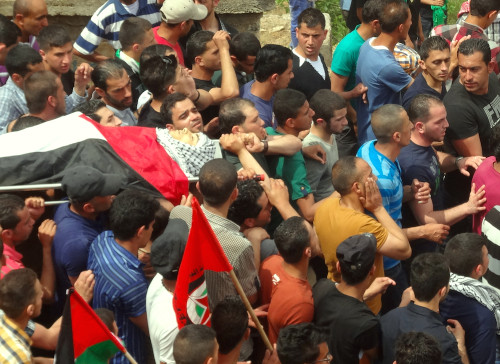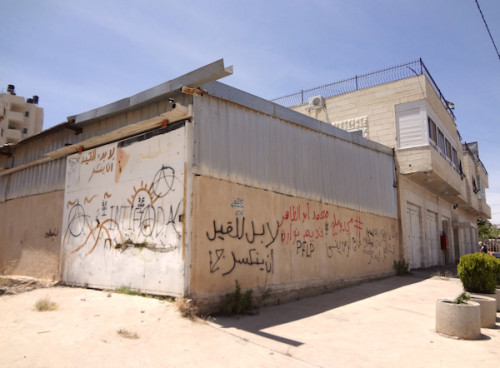THE STRANGEST THINGS become routine. Every weekday evening, a taxi idles outside the Ofer military prison compound in Beitunia, about 10 minutes south of Ramallah, waiting for the gate to slide open and a few dazed men to walk through carrying their belongings in sealed plastic bags as they step into freedom, or at least into the more spacious prison known as the West Bank. Sometimes there’s a van there selling coffee, chips, and candy bars to the prisoners’ families as they wait in the dusty lot outside the compound, which also houses an Israeli army base, a checkpoint for trucks crossing into Israel, and a military court — West Bank Palestinians are tried in military rather than civil proceedings. The conviction rate, the last time it was published, stood at 99.74 percent. Prison hence plays an outsized role in West Bank life: nearly half of all Palestinian males have at some point been incarcerated.
Every Friday, when the courts are closed and no prisoners can be released, teenage boys and young men from Beitunia, Ramallah, and the surrounding villages gather on the long straight road outside the jail to hurl stones in the direction of the metal gate. They rarely get close enough to hit it. Soldiers respond with plastic-coated steel bullets, copious quantities of tear gas, occasionally with live fire. Sometimes the clashes drift from Fridays into the workweek. Sometimes someone throws a Molotov. Sometimes dozens take part, sometimes just a handful. The Israeli military spokespeople — and following their lead, most of the Israeli media — call the clashes “riots,” a word that effectively strips them of all political intent, and their participants of anything like rational agency. They are not riots, and they are not exactly demonstrations. Most West Bank protests have some clear symbolic goal: to close a road or push through a checkpoint, to breach a fence, to reach land seized by settlers. At Ofer prison, kids risk death to throw rocks at the jail that will likely one day hold them, usually from a distance too great to reach their target. Despair too has its routines.
I was in downtown Ramallah when I heard. Someone had been killed outside the prison. It was May 15, Nakba Day, the 66th anniversary of the uprooting of more than 700,000 Palestinians from cities and villages in what would become the state of Israel. (Ask the Cherokee: one man’s patriotic holiday is another man’s calamity.) Black flags hung from the lampposts. I went over to the hospital and found a few hundred people gathered in the courtyard. At the gate, I ran into a medic I knew named Ahmad Nasser. He had just come from Ofer. There were two dead, he said. He had brought the first one. His name turned out to be Nadim Nawara. He had been shot in the heart. He was 17.
Nasser told me he had seen the Israeli commander peering through binoculars and pointing at targets for snipers to shoot. Nine had been hit altogether, he said, all with live fire. The other boy who had died was also shot in the chest. His name was Mohammad Abu Thaher. He was also 17.(Other media sources have given different accounts of his age, ranging from 15 to 22.)I found Mohannad Darabee, the medic who had first reached Abu Thaher. “We heard the shot and we all went down,” he said. “We looked back and he was still on the ground. He screamed and then he didn’t say anything else.”
The concrete blast wall outside Ofer. Witnesses reported that the shot that killed Nawara was fired by soldiers gathered behind this wall.
The street outside the hospital was crowded. Teenagers, some of them still wearing their school uniforms, walked by in tears. Others sat on the sidewalk weeping. Twice I saw a group of kids carry a boy flailing with grief into the emergency room. A crowd had gathered outside the hospital morgue, a low building of stained stucco. Nadim Nawara’s father was there. He was in his mid 40s, his hair prematurely gray. Cameras surrounded him as he waited to see his son’s remains. Again and again he called out to God and to his son. “Oh my darling,” he yelled out again and again. “If only, if only,” he cried. Behind him, a woman wailed, screaming.
At a little after five, a march took shape: a few hundred people clapping and chanting. Some of the youth whom I had earlier seen embracing one another in tears walked in the front, shouting out nationalist chants. Quickly, private grief transmuted into public rage. They marched from the hospital gate to the morgue and back again, then out into the streets of the city. “The blood of the martyrs is calling,” they shouted. The boy I had seen carried into the ER earlier lay collapsed on the concrete, gasping for breath, alone.
I spotted Rajai Abu Khalil, a young doctor who works in the ER, standing outside the hospital, smoking a cigarette. “It was crazy in there,” he said. One of the injured was still in intensive care. He too had been shot in the chest. “He might make it,” he said. “He might not.” The rest had been hit in the extremities. All would be okay. But Abu Khalil had no doubt that the soldiers had used live ammunition. (The Israeli media was already repeating the IDF’s claim that soldiers at Ofer had only fired rubber bullets.) “There were exit wounds,” Abu Khalil said. Nawara was still alive when he arrived at the hospital. When they opened his chest, “his heart was just destroyed.” He died minutes later. Abu Khalil took a long drag on his cigarette. “They’re kids,” he said, “all of them.”
¤
By evening, the photos were up on Facebook: Nadim spinning a basketball, Mohammad grinning, Nadim taking a selfie in his Boy Scout uniform with a friend’s arm around his shoulder, both boys prone on the asphalt on the road outside of Ofer. The next morning I went to the funeral. There were too many people to fit inside the mosque, so prayers were held in a field just beneath the campus of Bir Zeit University. Giant blue and black tarps had been laid on the ground so that mourners would not dirty their clothes when they kneeled to pray, but the tarps weren’t big enough to hold everyone. Some men brought their own prayer rugs. Others knelt on newspapers, or on their keffiyehs, on yellow Fatah flags or green Hamas ones. At the center of the crowd, in the front, the two corpses lay on biers, their bodies wrapped in Palestinian flags, a yellow flag on Nadim Nawara’s chest, a green one on Mohammad Abu Thaher’s.
Nadim Nawara’s funeral procession, in the West Bank village of Mazra’a al Qabilia.
After the prayer, when everyone was on their feet again and the political speeches had ended, pallbearers lifted Nawara’s body onto their shoulders and began to carry him down the long winding road into the valley below, toward his family’s village, Mazra’a al Qabilia. Women watched from the balconies, weeping. Drummers in Boy Scout uniforms led the procession through the narrow streets of the village. Behind them bobbed Nawara on his bier in a horrid parody of sleep: his eyes closed, cheeks smooth and slightly yellowed, lips parted just enough to show his teeth. The men immediately around him clapped and chanted, but behind them the marchers walked in silence until they reached the village cemetery, on a steep hillside overgrown with grass and thistle. Just down the valley was a cluster of white trailers, an “outpost,” a settlement in embryo. Two radio towers protruded from the more established settlements just beyond the hills. Nearly every door and every wall in the village bore a poster of Nawara: a short-haired boy in a T-shirt and hoodie, facing the camera, his jaw and mouth twisted slightly, as if he were about to speak, or about to smile.
Late that afternoon, I took a taxi out to Ofer. The clashes were nearly over when I arrived. Only five or six young men remained, taking turns running to hurl stones at an enemy too far away to see. Two ambulances waited idling beside them.
I returned two days later with Mohannad Darabee, the medic who had treated Abu Thaher, and with Samer Nazzal, a photojournalist who had been a few feet from Nawara when he was shot. “It was exactly here,” Nazzal said, standing in the middle of the street. The gates to the prison were not even visible from where we stood. There were about 60 people on the street that afternoon, he said, 10 or 12 throwing stones and another 50 lingering farther back. It was, Nazzal said, a “normal” clash, even a calm one. Twenty or 30 soldiers had gathered behind a concrete blast wall at the edge of the prison parking lot 200 meters down the road. A smaller group of Israeli Border Police stood on the hillside about 10 meters above the street and 50 meters away.
The building beside which Nawara and Abu Thaher were shot. Their names have already been painted on the wall, in red.
Both groups were far too distant to be in any danger of being hit by stones, but the soldiers, Nazzal said, were using live ammunition from the moment he arrived at the scene. They were not shooting wildly. “Each time it was just one shot,” he said. “Like a sniper.” He had been there for less than 15 minutes when Nawara was hit. “At the moment he was shot he was just standing in the street. They saw him and they shot him.” Darabee arrived at the scene about 15 minutes after the ambulance took Nawara away. No one there yet knew that Nawara’s wound was fatal. Abu Thaher, Darabee said, had just thrown a stone toward the Border Police on the hill and run to take cover behind a building. He was shot through the back and fell on a driveway about 10 meters from the spot where Nawara had fallen. Darabee put his hand over the exit wound on the boy’s chest to stop it from bleeding. “He put his hand on my hand,” Darabee said, and didn’t move again. “He died when we were walking him to the ambulance. We thought he fainted.”
The owner of the building invited us into his office for coffee. His security cameras had recorded the shootings, he said, but he had given the footage to the Palestinian police. (He also gave a copy to the NGO Defence for Children International, who posted it online.) Both witnesses told me that they had seen commanders choosing targets and pointing to them before each shot rang out. The army commander behind the blast wall, Darabee said, was using binoculars. The Border Police commander on the hillside, Nazzal said, didn’t need them. He pointed, a soldier fired, Nawara fell. “I have been to many clashes and I’ve never seen this before,” Nazzal said. “They were hunting.”
Ben Ehrenreich is Mideast correspondent for LARB. Photos by the author.



